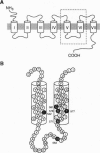Abstract
Genomic DNA from 32 unrelated families with male-limited precocious puberty was examined for the previously described Asp-578-->Gly, Met-571-->Ile, and Thr-577-->Ile mutations in transmembrane helix 6 of the human luteinizing hormone receptor (hLHR). Twenty-eight families had the inherited form of the disorder, and of these, 24 were found to have the Asp-578-->Gly mutation. Four additional mutations were found among the remaining four families with the inherited form and in four sporadic cases of the disorder: an A-->C transversion resulting in substitution of leucine for Ile-542 in the fifth transmembrane helix, an A-->G transition resulting in substitution of glycine for Asp-564 in the third cytoplasmic loop, a G-->T transversion resulting in substitution of tyrosine for Asp-578 in the sixth transmembrane helix, and a T-->C transition resulting in substitution of arginine for Cys-581 in the sixth transmembrane helix. Human embryonic kidney cells transfected with cDNAs for each of the mutant hLHRs, created by PCR-based mutagenesis of the wild-type hLHR cDNA, exhibited increased levels of basal cAMP production in the absence of agonist, indicating constitutive activation of the mutation hLHRs. Three of the additional mutations had specific features: Ile-542-->Leu and Cys-581-->Arg appeared ligand-unresponsive, whereas Asp-578-->Tyr appeared to correlate genotype with phenotype. We conclude that the region spanning nt 1624-1741 of exon 11 is a hotspot for heterogeneous point mutations that constitutively activate the hLHR and cause male-limited precocious puberty.
Full text
PDF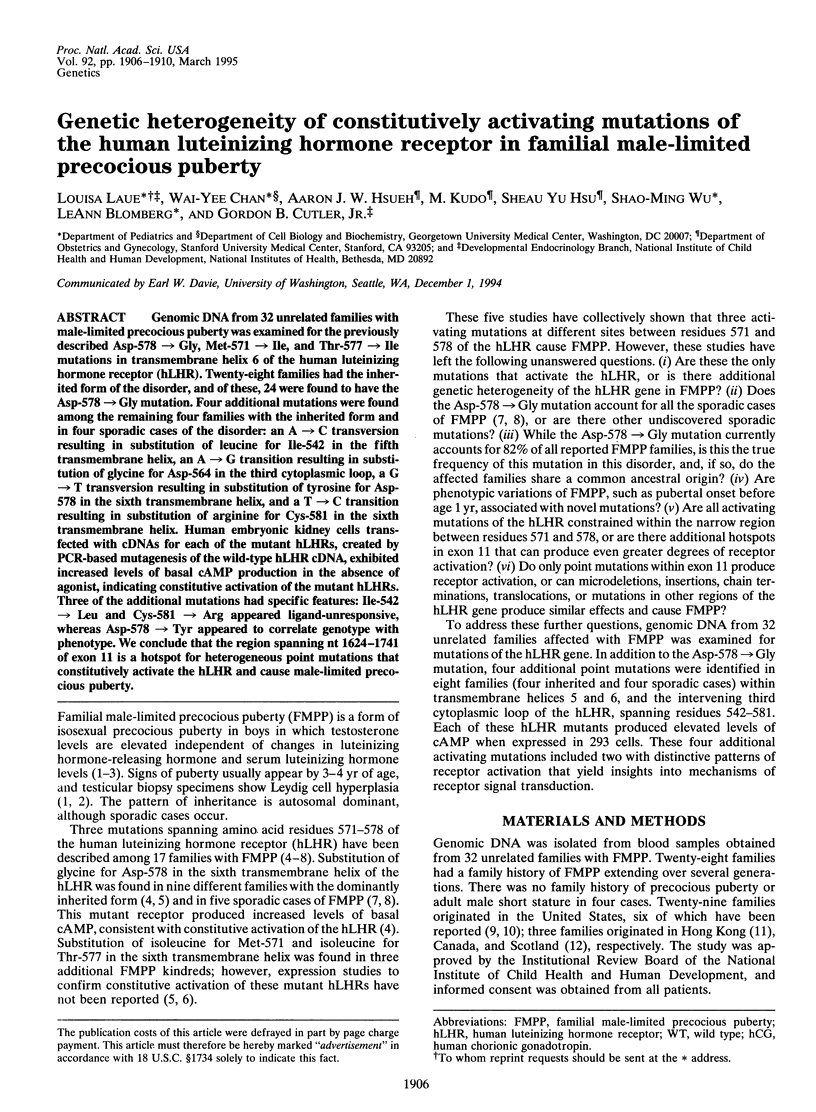
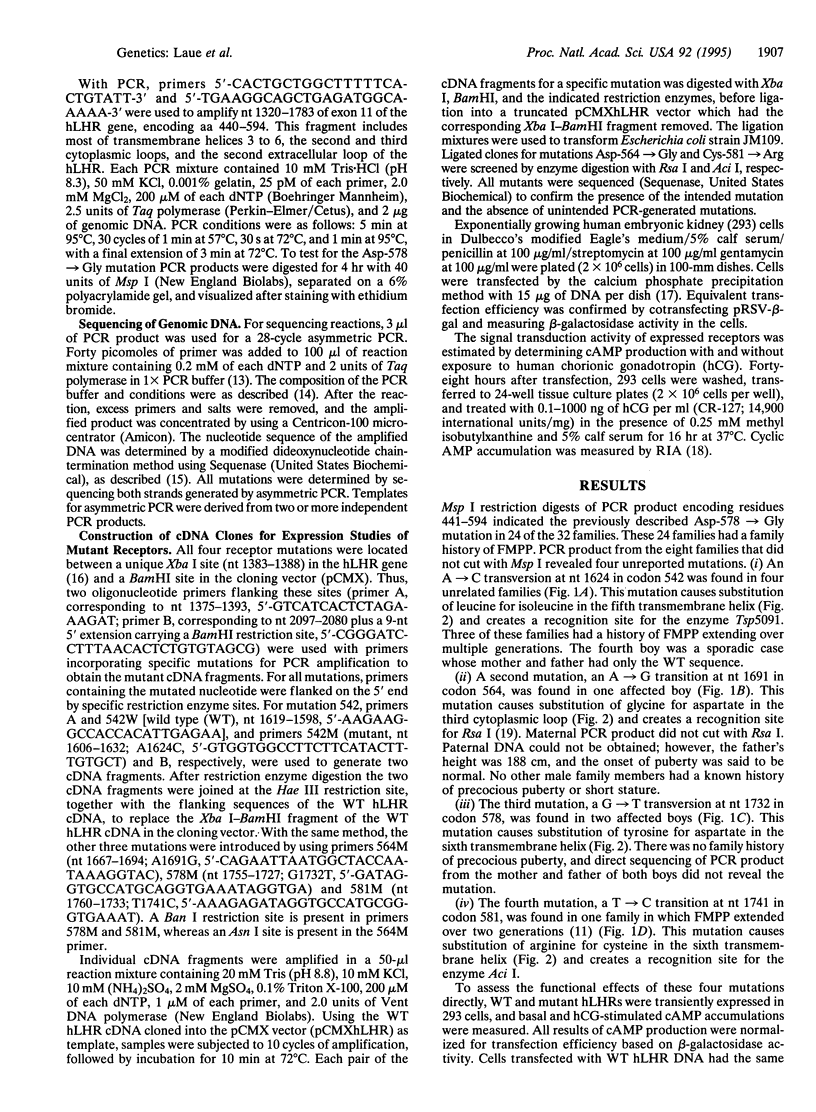
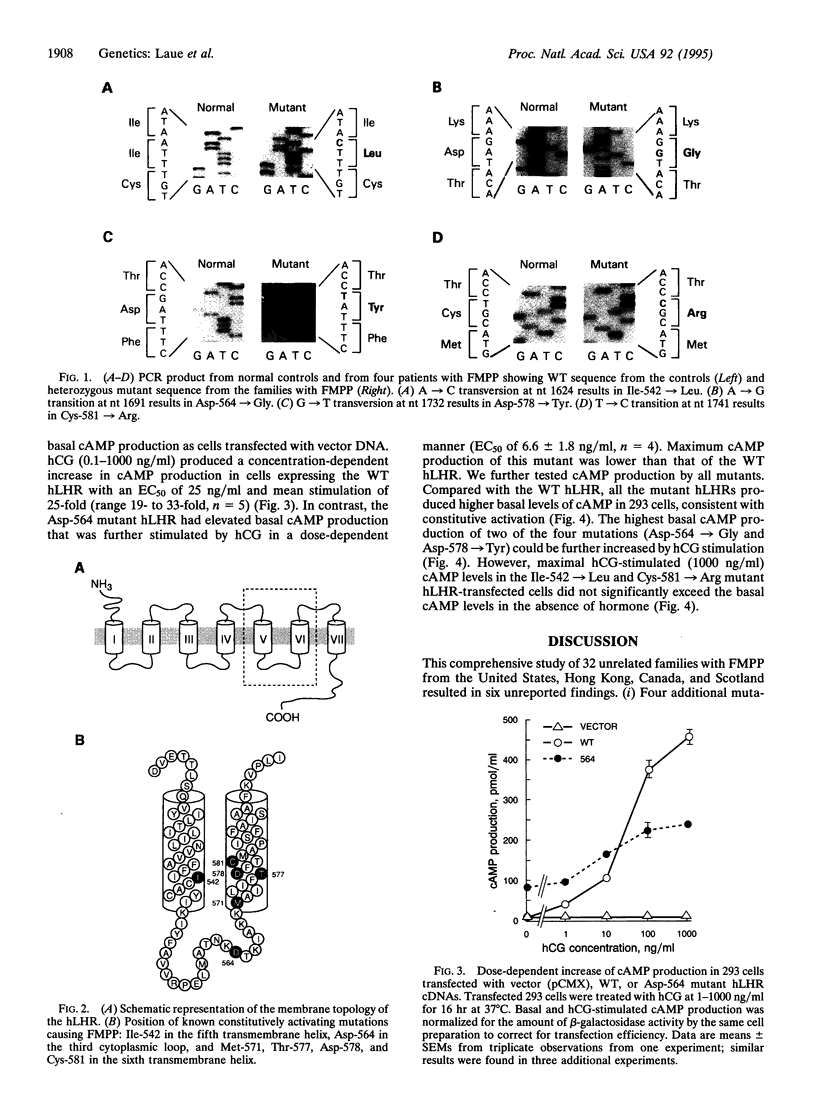
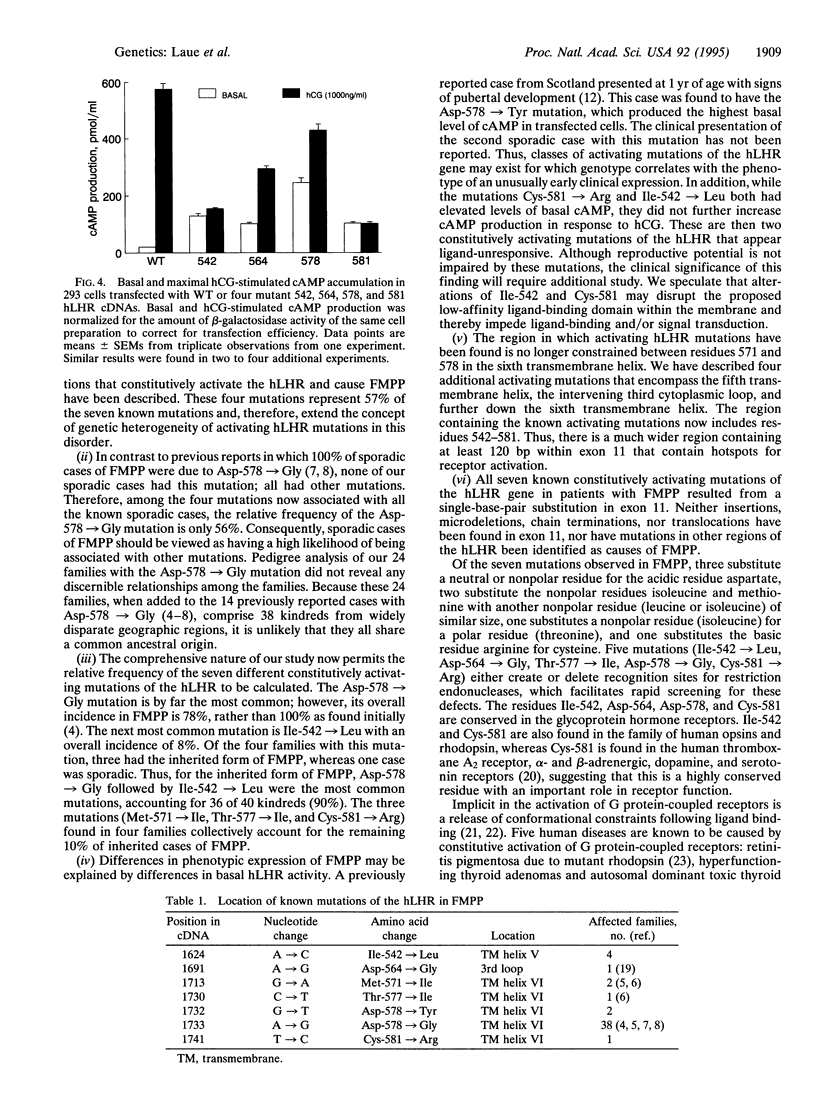
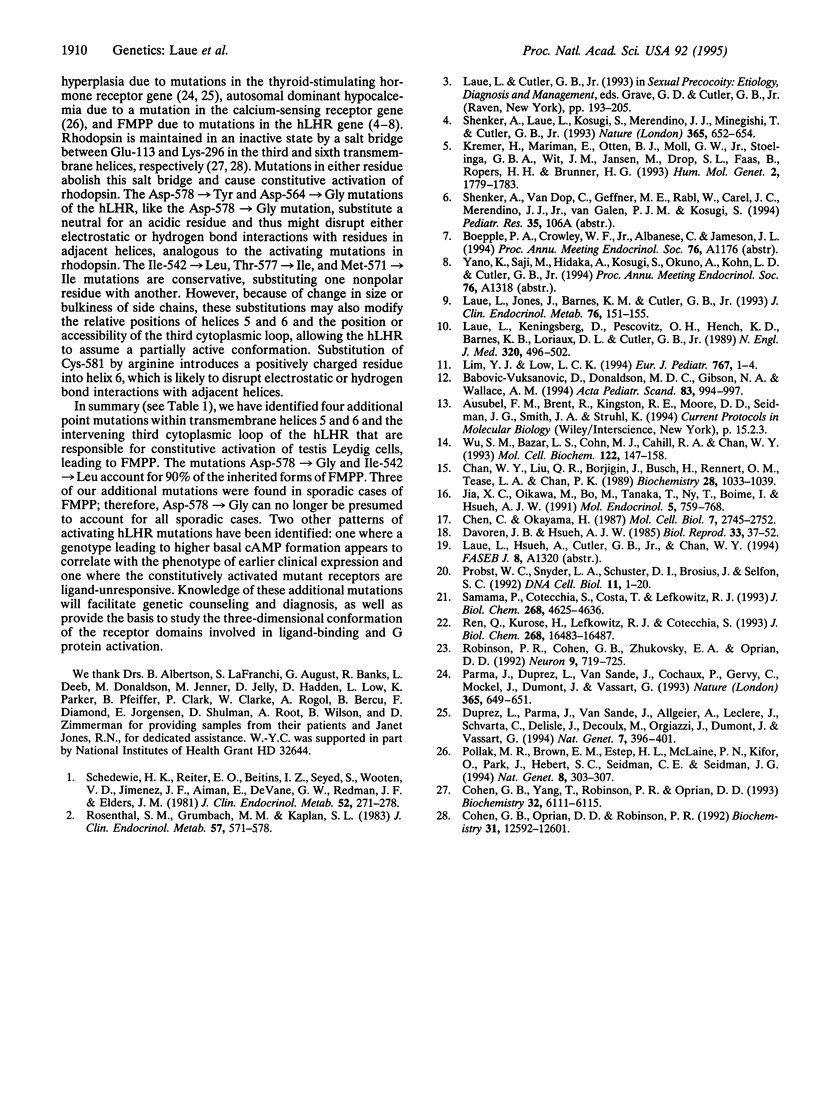
Images in this article
Selected References
These references are in PubMed. This may not be the complete list of references from this article.
- Babovic-Vuksanovic D., Donaldson M. D., Gibson N. A., Wallace A. M. Hazards of ketoconazole therapy in testotoxicosis. Acta Paediatr. 1994 Sep;83(9):994–997. doi: 10.1111/j.1651-2227.1994.tb13192.x. [DOI] [PubMed] [Google Scholar]
- Chan W. Y., Liu Q. R., Borjigin J., Busch H., Rennert O. M., Tease L. A., Chan P. K. Characterization of the cDNA encoding human nucleophosmin and studies of its role in normal and abnormal growth. Biochemistry. 1989 Feb 7;28(3):1033–1039. doi: 10.1021/bi00429a017. [DOI] [PubMed] [Google Scholar]
- Chen C., Okayama H. High-efficiency transformation of mammalian cells by plasmid DNA. Mol Cell Biol. 1987 Aug;7(8):2745–2752. doi: 10.1128/mcb.7.8.2745. [DOI] [PMC free article] [PubMed] [Google Scholar]
- Cohen G. B., Oprian D. D., Robinson P. R. Mechanism of activation and inactivation of opsin: role of Glu113 and Lys296. Biochemistry. 1992 Dec 22;31(50):12592–12601. doi: 10.1021/bi00165a008. [DOI] [PubMed] [Google Scholar]
- Cohen G. B., Yang T., Robinson P. R., Oprian D. D. Constitutive activation of opsin: influence of charge at position 134 and size at position 296. Biochemistry. 1993 Jun 15;32(23):6111–6115. doi: 10.1021/bi00074a024. [DOI] [PubMed] [Google Scholar]
- Davoren J. B., Hsueh A. J. Vasoactive intestinal peptide: a novel stimulator of steroidogenesis by cultured rat granulosa cells. Biol Reprod. 1985 Aug;33(1):37–52. doi: 10.1095/biolreprod33.1.37. [DOI] [PubMed] [Google Scholar]
- Duprez L., Parma J., Van Sande J., Allgeier A., Leclère J., Schvartz C., Delisle M. J., Decoulx M., Orgiazzi J., Dumont J. Germline mutations in the thyrotropin receptor gene cause non-autoimmune autosomal dominant hyperthyroidism. Nat Genet. 1994 Jul;7(3):396–401. doi: 10.1038/ng0794-396. [DOI] [PubMed] [Google Scholar]
- Jia X. C., Oikawa M., Bo M., Tanaka T., Ny T., Boime I., Hsueh A. J. Expression of human luteinizing hormone (LH) receptor: interaction with LH and chorionic gonadotropin from human but not equine, rat, and ovine species. Mol Endocrinol. 1991 Jun;5(6):759–768. doi: 10.1210/mend-5-6-759. [DOI] [PubMed] [Google Scholar]
- Kremer H., Mariman E., Otten B. J., Moll G. W., Jr, Stoelinga G. B., Wit J. M., Jansen M., Drop S. L., Faas B., Ropers H. H. Cosegregation of missense mutations of the luteinizing hormone receptor gene with familial male-limited precocious puberty. Hum Mol Genet. 1993 Nov;2(11):1779–1783. doi: 10.1093/hmg/2.11.1779. [DOI] [PubMed] [Google Scholar]
- Laue L., Jones J., Barnes K. M., Cutler G. B., Jr Treatment of familial male precocious puberty with spironolactone, testolactone, and deslorelin. J Clin Endocrinol Metab. 1993 Jan;76(1):151–155. doi: 10.1210/jcem.76.1.8421081. [DOI] [PubMed] [Google Scholar]
- Laue L., Kenigsberg D., Pescovitz O. H., Hench K. D., Barnes K. M., Loriaux D. L., Cutler G. B., Jr Treatment of familial male precocious puberty with spironolactone and testolactone. N Engl J Med. 1989 Feb 23;320(8):496–502. doi: 10.1056/NEJM198902233200805. [DOI] [PubMed] [Google Scholar]
- Parma J., Duprez L., Van Sande J., Cochaux P., Gervy C., Mockel J., Dumont J., Vassart G. Somatic mutations in the thyrotropin receptor gene cause hyperfunctioning thyroid adenomas. Nature. 1993 Oct 14;365(6447):649–651. doi: 10.1038/365649a0. [DOI] [PubMed] [Google Scholar]
- Pollak M. R., Brown E. M., Estep H. L., McLaine P. N., Kifor O., Park J., Hebert S. C., Seidman C. E., Seidman J. G. Autosomal dominant hypocalcaemia caused by a Ca(2+)-sensing receptor gene mutation. Nat Genet. 1994 Nov;8(3):303–307. doi: 10.1038/ng1194-303. [DOI] [PubMed] [Google Scholar]
- Probst W. C., Snyder L. A., Schuster D. I., Brosius J., Sealfon S. C. Sequence alignment of the G-protein coupled receptor superfamily. DNA Cell Biol. 1992 Jan-Feb;11(1):1–20. doi: 10.1089/dna.1992.11.1. [DOI] [PubMed] [Google Scholar]
- Ren Q., Kurose H., Lefkowitz R. J., Cotecchia S. Constitutively active mutants of the alpha 2-adrenergic receptor. J Biol Chem. 1993 Aug 5;268(22):16483–16487. [PubMed] [Google Scholar]
- Robinson P. R., Cohen G. B., Zhukovsky E. A., Oprian D. D. Constitutively active mutants of rhodopsin. Neuron. 1992 Oct;9(4):719–725. doi: 10.1016/0896-6273(92)90034-b. [DOI] [PubMed] [Google Scholar]
- Rosenthal S. M., Grumbach M. M., Kaplan S. L. Gonadotropin-independent familial sexual precocity with premature Leydig and germinal cell maturation (familial testotoxicosis): effects of a potent luteinizing hormone-releasing factor agonist and medroxyprogesterone acetate therapy in four cases. J Clin Endocrinol Metab. 1983 Sep;57(3):571–579. doi: 10.1210/jcem-57-3-571. [DOI] [PubMed] [Google Scholar]
- Samama P., Cotecchia S., Costa T., Lefkowitz R. J. A mutation-induced activated state of the beta 2-adrenergic receptor. Extending the ternary complex model. J Biol Chem. 1993 Mar 5;268(7):4625–4636. [PubMed] [Google Scholar]
- Schedewie H. K., Reiter E. O., Beitins I. Z., Seyed S., Wooten V. D., Jimenez J. F., Aiman E. J., DeVane G. W., Redman J. F., Elders M. J. Testicular leydig cell hyperplasia as a cause of familial sexual precocity. J Clin Endocrinol Metab. 1981 Feb;52(2):271–278. doi: 10.1210/jcem-52-2-271. [DOI] [PubMed] [Google Scholar]
- Shenker A., Laue L., Kosugi S., Merendino J. J., Jr, Minegishi T., Cutler G. B., Jr A constitutively activating mutation of the luteinizing hormone receptor in familial male precocious puberty. Nature. 1993 Oct 14;365(6447):652–654. doi: 10.1038/365652a0. [DOI] [PubMed] [Google Scholar]
- Wu S. M., Bazar L. S., Cohn M. L., Cahill R. A., Chan W. Y. Expression of pregnancy-specific beta 1-glycoprotein genes in hematopoietic cells. Mol Cell Biochem. 1993 May 26;122(2):147–158. doi: 10.1007/BF01076099. [DOI] [PubMed] [Google Scholar]




